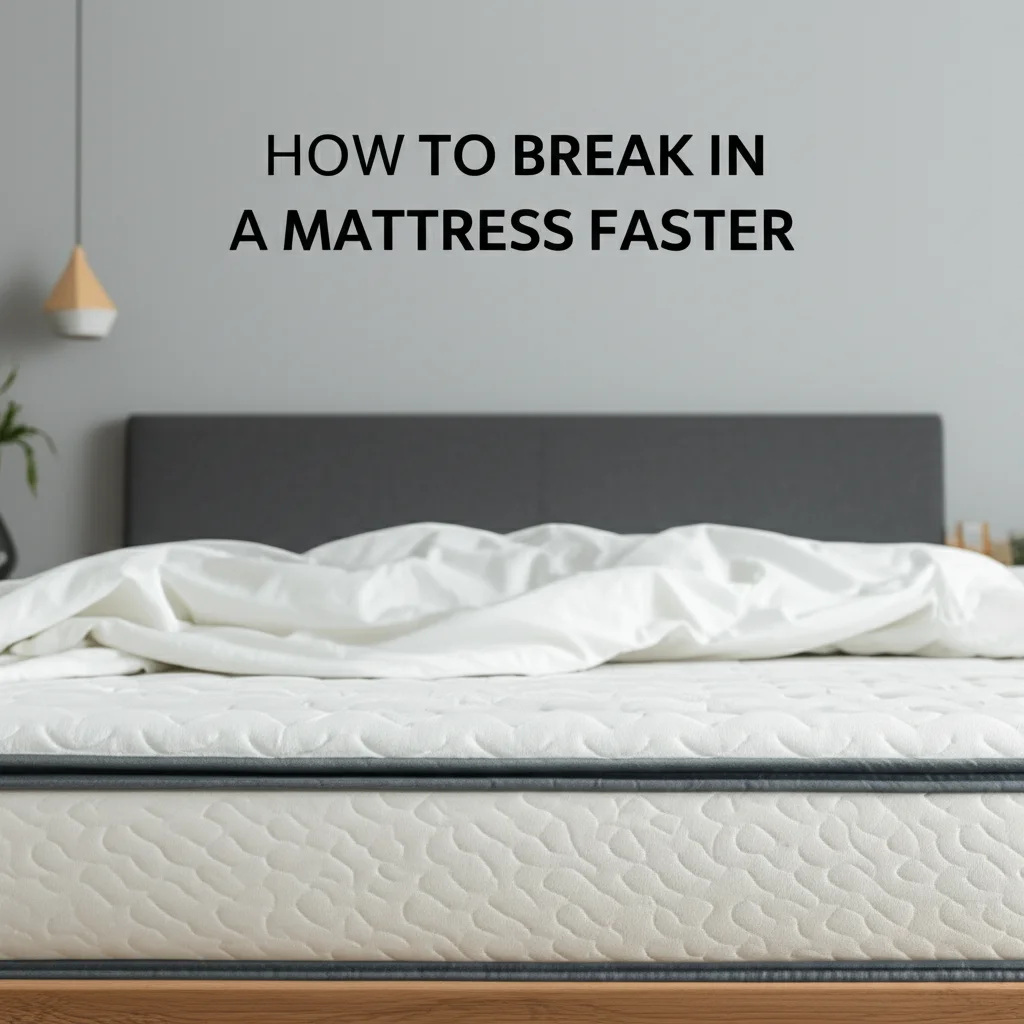· Todd Martin · Home Comfort · 13 min read
How To Break In A Mattress Faster

How To Break In A Mattress Faster for Better Sleep
There is nothing quite like the feeling of a brand new mattress. You unbox it, set it up, and eagerly anticipate perfect sleep. Yet, many people find their new mattress feels much firmer than expected. This initial firmness is normal; it means your mattress needs time to adjust. Breaking in a mattress ensures it conforms to your body, offering the comfort and support you bought it for. This guide shares actionable strategies to help you break in a mattress faster, leading to quicker comfort and better sleep. We will cover various methods, from simple daily habits to more intensive techniques. You will learn what to expect during the break-in period and how to care for your new sleep surface.
Takeaway
Breaking in a new mattress takes time and effort. You can speed up the process by consistently using and manipulating the mattress. This ensures the materials soften and adapt to your body shape.
- Maximize sleep time on the mattress.
- Walk on the mattress surface regularly.
- Rotate the mattress often.
- Apply pressure to different areas.
- Ensure proper foundation support.
Clear, Concise Answer to Main Query
You can break in a new mattress faster by regularly sleeping on it, walking on its surface, and applying pressure to all areas. Consistent use and movement help soften the new materials. This allows the mattress to conform better to your body shape.
Understanding the Mattress Break-In Period
Bringing a new mattress home starts a unique adjustment phase. This period is called the break-in phase. During this time, the materials inside your mattress, like foam layers or coils, start to soften. They adapt to your body weight and sleep patterns. Think of it like breaking in new shoes; they feel stiff at first, then mold to your feet over time.
Many new mattresses feel firmer than the display model in the store. This difference is due to the factory-fresh materials. These materials have not yet experienced the warmth and pressure from human use. Mattress companies design their products to be durable and supportive. They use dense foams and robust springs. These need time to lose their initial rigidity. Patience is a key part of this process. Most mattresses require 30 to 90 nights of consistent use to fully break in. Some mattresses, especially those with high-density foam, might take even longer. Understanding this initial firmness is important. It is not a sign of a bad mattress. It is a normal part of the process.
The break-in period is crucial for your long-term comfort. A properly broken-in mattress provides optimal pressure relief and spinal alignment. This helps prevent aches and pains. It also ensures you get the most out of your investment. During this time, your body also adjusts to the new sleep surface. This dual adjustment means both you and your mattress are adapting. If your new mattress feels too firm, you might wonder how to tell if mattress is too firm. The break-in period addresses this initial firmness.
Maximizing Sleep Time on Your New Mattress
The simplest and most effective way to break in a new mattress is to use it. This means sleeping on it as much as possible. Your body weight and warmth are the primary tools for softening the mattress materials. Each night you spend on your mattress contributes to its break-in. The pressure from your body helps compress the foams and springs. The warmth from your body helps make foam materials more pliable.
Make an effort to spend full nights on your new bed. Avoid sleeping on a spare bed or couch, even if the new mattress feels a bit uncomfortable at first. Consistency is very important here. The more hours you spend lying on the mattress, the faster it will adapt. Encourage family members or partners to also spend time on the bed if it is a shared mattress. Their weight contributes to the overall softening. Different sleep positions apply pressure differently. This helps break in various zones of the mattress.
Do not just lie in one spot. Move around a little. Change your sleeping position if comfortable. This distributes pressure evenly across the surface. It ensures all areas of the mattress get some attention. Consistent use helps the mattress reach its intended firmness level. It allows the materials to settle naturally. This consistent use prevents premature sagging in specific areas. It also helps achieve uniform comfort across the entire bed. Remember, patience is a virtue during this process. Each night brings you closer to your ideal sleep surface.
Actively Walking and Rolling on the Mattress
Beyond just sleeping, actively walking or rolling on your new mattress can significantly speed up the break-in process. This method provides more concentrated and varied pressure than just lying down. It targets areas that might not get as much attention during sleep. Begin by removing all bedding from the mattress. This gives you clear access to the entire surface.
Gently walk across the mattress on your hands and knees. Alternatively, you can walk lightly on your feet. Make sure your weight is distributed. Cover the entire surface, from edge to edge. Focus extra attention on the center areas. These spots often bear the most weight. Spend 5-10 minutes doing this each day. You do not need to jump or apply excessive force. Gentle, consistent pressure is enough. This action helps compress the internal layers. It also works out any initial stiffness in the materials.
You can also roll a bowling ball or heavy object across the surface. This applies consistent, even pressure. It helps soften the foam layers. This method is especially useful for dense foam mattresses. These types of mattresses take longer to break in. The rolling motion mimics body movement. It encourages the materials to relax and become more flexible. Combine this with your nightly sleep for best results. This technique will help you achieve the desired comfort level faster. Remember to be gentle to avoid damage. This active approach significantly shortens the break-in period.
Rotating and Flipping Your Mattress Regularly
Proper rotation and, if applicable, flipping are essential for uniform break-in and mattress longevity. Many modern mattresses are “no-flip” designs. These mattresses have distinct top and bottom layers. Check your mattress manufacturer’s guidelines first. If your mattress is a no-flip design, you will only rotate it. Rotation means turning the mattress 180 degrees. The head of the bed becomes the foot, and vice-versa.
For mattresses that can be flipped, you turn it over entirely. This places the bottom surface on top. This method distributes wear and tear. It helps all parts of the mattress get equal pressure during the break-in period. During the initial break-in period, I recommend rotating your mattress every two weeks. If it is flippable, flip it every two weeks too. After the break-in period, you can reduce this frequency. Four times a year is typically sufficient for maintenance.
Regular rotation prevents body impressions from forming too quickly in one spot. It allows different areas of the mattress to compress and soften evenly. This ensures consistent comfort across the entire sleeping surface. It also extends the lifespan of your mattress. For example, if one side feels significantly softer than the other, you might ask how to tell if mattress is too soft. Regular rotation helps prevent such uneven wear. This simple habit contributes greatly to a faster and more effective break-in. It also maintains mattress integrity over time.
Applying Pressure and Using Your Mattress Beyond Sleep
To break in your mattress faster, use it for more than just sleeping. Think of it as a piece of furniture that needs activity. Spending time on the mattress during the day helps. You can read a book, watch TV, or even work from your bed. These activities add extra pressure and movement to the mattress. They contribute to softening the materials more quickly.
Consider having children or pets spend time on the bed. Their weight and movement also contribute to the break-in. Just ensure they are gentle and do not cause damage. Every bit of distributed pressure helps. The goal is to vary the pressure points. This helps the mattress adapt more universally. For instance, sit on the edge while getting ready. Lean against the headboard while enjoying a morning coffee.
You can also manually apply pressure to specific spots. Use your hands or knees to push down on different areas. This is particularly useful for stubborn, firm spots. Spend a few minutes doing this daily. It helps target and release tension in the materials. Remember that consistency is key. Small, regular actions add up over time. These methods complement your nightly sleep. They accelerate the break-in process. This ensures your mattress reaches its optimal comfort level sooner.
The Importance of a Proper Mattress Foundation
A stable and supportive foundation is vital for a new mattress. It not only provides essential support but also influences the break-in process. An improper foundation can hinder the mattress from softening correctly. It can also cause premature wear. Always use the type of foundation recommended by your mattress manufacturer. This might be a box spring, a slatted base, or an adjustable bed frame.
If you use a slatted base, check the distance between the slats. Most mattress warranties require slats to be no more than 2-3 inches apart. Wider gaps can cause the mattress to sag between the slats. This creates uneven pressure points. It prevents the mattress from breaking in uniformly. It can also lead to structural damage over time. Ensure the foundation is level and sturdy. Any wobbling or unevenness can affect mattress performance.
A firm, even foundation allows the mattress to flex and conform as designed. It supports the internal components evenly. This promotes a consistent break-in across the entire surface. Without proper support, your new mattress may feel firmer in some areas. It might also develop soft spots in others. This unevenness can make it harder to get comfortable. Proper foundation use protects your mattress warranty. It also ensures you achieve the desired comfort level quickly. It helps you avoid discomfort, such as when you might start to wonder how to make a pillow-top mattress firm because the support underneath is lacking.
Addressing Off-Gassing and Initial Odors
When you unbox a new mattress, especially one made of foam, you might notice a distinct smell. This is called off-gassing. It is a common and normal part of the new mattress experience. The odor comes from Volatile Organic Compounds (VOCs) released by the foam materials. While these compounds are generally harmless, the smell can be unpleasant. This off-gassing period often overlaps with the initial break-in phase.
To help dissipate the smell, ensure good ventilation in your bedroom. Open windows and doors. Use a fan to circulate air. If possible, let the mattress air out in a well-ventilated room for a few hours or even a full day before putting on bedding. This allows much of the initial odor to escape. Some people are more sensitive to these smells than others. If you are particularly sensitive, airing it out longer is a good idea.
The smell usually fades within a few days to a week. For persistent odors, consider using natural deodorizers. Sprinkle baking soda lightly over the mattress surface. Let it sit for several hours. Then, vacuum it thoroughly. This can absorb lingering smells. Another option is to use an air purifier in the room. Ensuring fresh air helps clear the smell. This also creates a more pleasant sleeping environment as you break in your mattress. For more tips, you can refer to guides on how to get rid of smell from new mattress or how to deodorize a mattress without baking soda. Addressing off-gassing is an important step in fully enjoying your new bed.
Caring for Your Mattress Beyond Break-In
Once your mattress is broken in, proper care ensures its longevity and sustained comfort. A well-maintained mattress will serve you well for many years. Continue regular rotation, even if it is less frequent than during break-in. For most mattresses, rotating every three to six months is ideal. This prevents uneven wear and tear. It also helps maintain consistent support across the surface.
Invest in a good quality mattress protector. A protector shields your mattress from spills, stains, dust mites, and allergens. This keeps your sleep environment clean and hygienic. It also helps preserve your mattress warranty. Clean spills immediately to prevent permanent damage. Spot clean your mattress as needed, following the manufacturer’s instructions. Avoid harsh chemicals that can damage materials.
Vacuum your mattress periodically. This removes dust, dead skin cells, and other debris. It keeps the surface clean and fresh. Air out your mattress occasionally by removing bedding. This allows moisture to evaporate. It helps prevent mildew or odors. Following these care tips helps your mattress stay supportive and comfortable. It maximizes your investment. A well-cared-for mattress provides consistent, good sleep night after night.
FAQ Section
How long does it usually take to break in a new mattress?
Most new mattresses need about 30 to 90 nights of consistent use to fully break in. This period allows the materials to soften and adapt to your body’s shape. High-density foam mattresses might take slightly longer. Patience is important during this initial adjustment phase.
Can I really walk on my new mattress?
Yes, you can gently walk on your new mattress to help break it in faster. Use light, even steps across the entire surface. This applies additional pressure. It helps compress the internal materials beyond just sleeping. Do this for 5-10 minutes a day. Avoid jumping or harsh impacts.
Why does my new mattress feel so firm?
New mattresses feel firm because their materials are factory-fresh and not yet compressed. Foams and coils are stiff and need time to soften. Your body weight and warmth help break down this initial rigidity. The firmness is a normal part of the break-in process.
Is off-gassing from a new mattress harmful?
Off-gassing refers to the smell from a new mattress, typically from VOCs. These compounds are generally considered harmless in the levels released by mattresses. The smell usually dissipates within a few days to a week. Proper ventilation helps clear the odor quickly.
What if my mattress still feels too firm after the break-in period?
If your mattress feels too firm after 90 days, consider adding a mattress topper. A topper can add an extra layer of softness and pressure relief. Ensure your foundation is correct, as improper support can make a mattress feel firmer. Contact the retailer if you have concerns about the warranty.
Should I flip my new mattress?
Many modern mattresses are “no-flip” designs. These mattresses have specific comfort layers on top. Check your mattress manufacturer’s guidelines for rotation and flipping. If it is a no-flip, only rotate it 180 degrees regularly. If it is flippable, flip and rotate it.
Conclusion
Getting a new mattress is an exciting step toward better sleep, but the initial firmness can be a surprise. Understanding how to break in a mattress faster makes this transition smooth and quick. Remember, patience combined with active strategies yields the best results. By consistently sleeping on your new bed, actively walking and rolling on its surface, and rotating it regularly, you accelerate the softening process. Ensuring proper foundation support and addressing off-gassing also contribute to a better overall experience.
A well-broken-in mattress will provide the comfort and support you deserve for years to come. Do not hesitate to incorporate these simple, effective techniques into your routine. Soon, your new mattress will feel like a custom-made haven, perfectly contoured to your body. Embrace this adjustment period, and you will unlock the full potential of your new sleep system. Start today and enjoy the journey to your most comfortable sleep yet.





